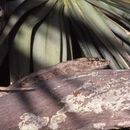Biology
provided by Arkive
The Round Island day gecko feeds on insects and other invertebrates, and is also known to lick pollen, nectar and ripe fruit (2).
Breeding all year round, the Round Island day gecko lays two eggs per clutch and up to six clutches per year. In the wild, eggs are often found in communal egg-laying sites stuck to the underside of rocks (6).
Conservation
provided by Arkive
A captive breeding programme has taken place at the Durrell Wildlife Conservation Trust, (formerly Jersey Wildlife Preservation Trust), but is no longer run (2). The population on Round Island is monitored on a regular basis (6).
Description
provided by Arkive
Stocky in shape, the Round Island day gecko is one of the largest day geckoes of this genus. The colouration is a dull brownish-grey with a dark stripe connecting the nostrils, eyes and the ear hole. On the back dark spots may be present. In some individuals, the legs and toes have light yellow bars. The ventral side is white or yellowish. Unusually for the genus Phelsuma, the pupil of this gecko is vertically elliptical during the day (6).
Habitat
provided by Arkive
The Round Island day gecko is found on bottle palms, fan palms and Pandanus plants, but due to the destruction of these plants by tropical cyclones and over-grazing by goats and rabbits over the last 150 years, this gecko is also forced to live in lava rock crevices (2) (4). The island has high rainfall and an average temperature of 23 ºC (4).
Range
provided by Arkive
The Round Island day gecko lives only on Round Island, which is about 20 km northeast of Mauritius in the Indian Ocean (4). It was previously present on mainland Mauritius and Reunion Island before introduced predators like rats and cats and mongooses were introduced and hunted it to local extinction (2) (6).
Status
provided by Arkive
The Round Island day gecko is classified as Endangered (EN D) on the IUCN Red List 2003 and is listed on Appendix II of CITES (1) (3).
Threats
provided by Arkive
Over-grazing by goats and the massive impact of tropical cyclones on the vegetation of the island has resulted in a population reduction of this gecko to as few as between 600 - 1,500 individuals (5). The successful eradication of rabbits and goats and the very slow reforestation on Round Island led to a steady increase in numbers over the last decades (6).

